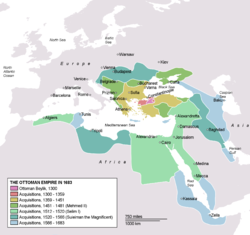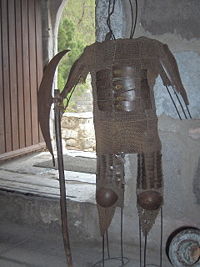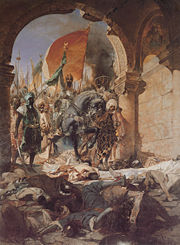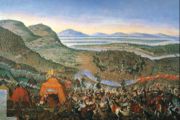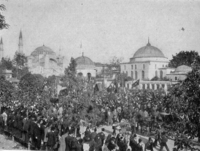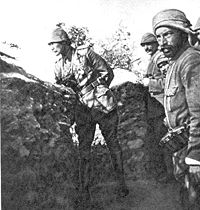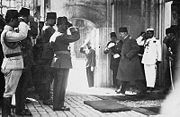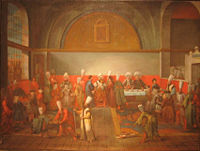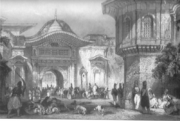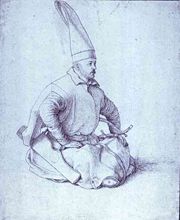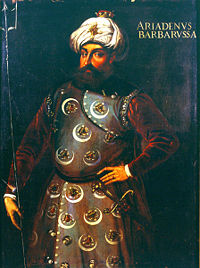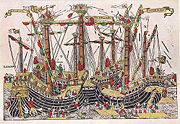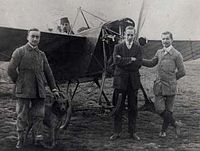Ottoman Empire
2008/9 Schools Wikipedia Selection. Related subjects: Ancient History, Classical History and Mythology
|
|||||||||||||||||||||||||||||||||||||||||||||||||||||||||||||||||
The Ottoman Empire (1299–1923) ( Old Ottoman Turkish: دولت عالیه عثمانیه Devlet-i Âliye-yi Osmâniyye, Late Ottoman and Modern Turkish: Osmanlı Devleti or Osmanlı İmparatorluğu), was a Turkish state. The state was known as the Turkish Empire or Turkey by its contemporaries. (See the other names of the Ottoman State.) It was succeeded by the Republic of Turkey, which was officially proclaimed on October 29, 1923.
At the height of its power (16th–17th century), it spanned three continents, controlling much of Southeastern Europe, the Middle East and North Africa. It stretched from the Strait of Gibraltar (and, in 1553, the Atlantic coast of Morocco beyond Gibraltar) in the west to the Caspian Sea and Persian Gulf in the east, and from the edge of Austria, Hungary and parts of Ukraine in the north to Sudan, Eritrea, Somalia and Yemen in the south. The Ottoman Empire contained 29 provinces, in addition to the tributary principalities of Moldavia, Transylvania, and Wallachia.
The empire was at the centre of interactions between the Eastern and Western worlds for six centuries. With Constantinople (Istanbul) as its capital city, and lands during the reign of Suleiman the Magnificent which largely corresponded to the lands ruled by Justinian the Great exactly 1000 years earlier, the Ottoman Empire was, in many respects, an Islamic successor to the Eastern Roman (Byzantine) Empire.
Rise (1299–1453)
With the demise of the Seljuk Sultanate of Rūm (about 1300), Turkish Anatolia was divided into a patchwork of independent states, the so-called Ghazi emirates.
By 1300, a weakened Byzantine Empire had seen most of its Anatolian provinces lost to ten Ghazi principalities. One of the Ghazi emirates was led by Osman I (from which the name Ottoman is derived), son of Ertuğrul in the region of Eskişehir in western Anatolia. According to tradition, as Ertuğrul migrated across Asia Minor leading approximately four hundred horsemen, he chanced upon a battle between two armies. Having decided to intervene, he chose the side of the losing army and turned the battle in their favour to secure victory. The troops he supported were those of a Seljuk Sultan who rewarded him with territory in Eskişehir. Following Ertuğrul's death in 1281, Osman became chief, or Bey, and by 1299 declared himself a sovereign ruler from the Seljuk state.
Osman I extended the frontiers of Ottoman settlement towards the edge of the Byzantine Empire. He moved the Ottoman capital to Bursa, and shaped the early political development of the nation. Given the nickname "Kara" ( Turkish for black) for his courage, Osman I was admired as a strong and dynamic ruler long after his death, as evident in the centuries-old Turkish phrase, "May he be as good as Osman." His reputation has also been burnished by the medieval Turkish story known as " Osman's Dream", a foundation myth in which the young Osman was inspired to conquest by a prescient vision of empire.
In this period, a formal Ottoman government was created whose institutions would remain largely unchanged for almost four centuries. The government used the legal entity known as the millet, under which religious and ethnic minorities were able to manage their own affairs with substantial independence from central control.
In the century after the death of Osman I, Ottoman rule began to extend over the Eastern Mediterranean and the Balkans. The important city of Thessaloniki was captured from the Venetians in 1387, and the Turkish victory at the Battle of Kosovo in 1389 effectively marked the end of Serbian power in the region, paving the way for Ottoman expansion into Europe. The Battle of Nicopolis in 1396, widely regarded as the last large-scale crusade of the Middle Ages, failed to stop the advance of the victorious Ottomans. With the extension of Turkish dominion into the Balkans, the strategic conquest of Constantinople became a crucial objective. The Empire controlled nearly all of the former Byzantine lands surrounding the city, but the Byzantines were temporarily relieved when Tamerlane invaded Anatolia with the Battle of Ankara in 1402, taking Sultan Bayezid I as a prisoner. Part of the Ottoman territories in the Balkans (such as Thessaloniki, Macedonia and Kosovo) were temporarily lost after 1402, but were later recovered by Murad II between the 1430s and 1450s.
The capture of Bayezid I threw the Turks into disorder. The state fell into a civil war which lasted from 1402 to 1413, as Bayezid's sons fought over succession. It ended when Mehmed I emerged as the sultan and restored Ottoman power, bringing an end to the Interregnum. His grandson, Mehmed the Conqueror, reorganized the state and the military, and demonstrated his martial prowess by capturing Constantinople on May 29, 1453, at the age of 21. The city became the new capital of the Ottoman Empire, and Mehmed II assumed the title of Kayser-i Rûm (Roman Emperor). However, this title was not recognized by the Greeks or Western Europe, and the Russian Czars also claimed to be the successors of the Eastern Imperial title. To consolidate his claim, Mehmed II aspired to gain control over the Western capital, Rome, and Ottoman forces occupied parts of the Italian peninsula, starting from Otranto and Apulia on July 28, 1480. But after Mehmed II's death on May 3, 1481, the campaign in Italy was cancelled and the Ottoman forces retreated.
Growth (1453–1683)
This period in Ottoman history can roughly be divided into two distinct eras: an era of territorial, economic, and cultural growth prior to 1566, followed by an era of relative military and political stagnation.
Expansion and apogee (1453–1566)
The Ottoman conquest of Constantinople in 1453 cemented the status of the Empire as the preeminent power in southeastern Europe and the eastern Mediterranean. During this time, the Ottoman Empire entered a long period of conquest and expansion, extending its borders deep into Europe and North Africa. Conquests on land were driven by the discipline and innovation of the Ottoman military; and on the sea, the Ottoman navy established the Empire as a great trading power. The state also flourished economically thanks to its control of the major overland trade routes between Europe and Asia.
The Empire prospered under the rule of a line of committed and effective sultans. Sultan Selim I (1512–1520) dramatically expanded the Empire's eastern and southern frontiers by defeating Shah Ismail of Safavid Persia, in the Battle of Chaldiran. Selim I established Ottoman rule in Egypt, and created a naval presence on the Red Sea. After this Ottoman expansion, a competition started between the Portuguese Empire and the Ottoman Empire to become the dominant power in the region.
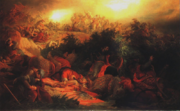
Selim's successor, Suleiman the Magnificent (1520–1566), further expanded upon Selim's conquests. After capturing Belgrade in 1521, Suleiman conquered the Kingdom of Hungary and established Ottoman rule in the territory of present-day Hungary and other Central European territories, after his victory in the Battle of Mohács in 1526. He then laid siege to Vienna in 1529, but failed to take the city after the onset of winter forced his retreat. In 1532, another planned attack on Vienna with an army thought to be over 250,000 strong was repulsed 60 miles (97 km) south of Vienna, at the fortress of Güns. After further advances by the Ottomans in 1543, the Habsburg ruler Ferdinand officially recognised Ottoman ascendancy in Hungary in 1547. During the reign of Suleiman, Transylvania, Wallachia and, intermittently, Moldavia, became tributary principalities of the Ottoman Empire. In the east, the Ottomans took Baghdad from the Persians in 1535, gaining control of Mesopotamia and naval access to the Persian Gulf. By the end of Suleiman's reign, the Empire's population reached about 15,000,000 people.

Under Selim and Suleiman, the Empire became a dominant naval force, controlling much of the Mediterranean Sea. The exploits of the Ottoman admiral Barbarossa Hayreddin Pasha, who commanded the Ottoman Navy during Suleiman's reign, led to a number of military victories over Christian navies. Among these were the conquest of Tunis and Algeria from Spain; the evacuation of Muslims and Jews from Spain to the safety of Ottoman lands (particularly Salonica, Cyprus, and Constantinople) during the Spanish Inquisition; and the capture of Nice from the Holy Roman Empire in 1543. This last conquest occurred on behalf of France as a joint venture between the forces of the French king Francis I and those of Barbarossa. France and the Ottoman Empire, united by mutual opposition to Habsburg rule in both Southern Europe and Central Europe, became strong allies during this period. The alliance was economic and military, as the sultans granted France the right of trade within the Empire without levy of taxation. In fact, the Ottoman Empire was by this time a significant and accepted part of the European political sphere, and entered into a military alliance with France, the Kingdom of England and the Dutch Republic against Habsburg Spain, Italy and Habsburg Austria.
As the 16th century progressed, Ottoman naval superiority was challenged by the growing sea powers of western Europe, particularly Portugal, in the Persian Gulf, Indian Ocean and the Spice Islands. With the Ottomans blockading sea-lanes to the East and South, the European powers were driven to find another way to the ancient silk and spice routes, now under Ottoman control. On land, the Empire was preoccupied by military campaigns in Austria and Persia, two widely-separated theatres of war. The strain of these conflicts on the Empire's resources, and the logistics of maintaining lines of supply and communication across such vast distances, ultimately rendered its sea efforts unsustainable and unsuccessful. The overriding military need for defence on the western and eastern frontiers of the Empire eventually made effective long-term engagement on a global scale impossible.
Revolts and revival (1566–1683)
Suleiman's death in 1566 marked the beginning of an era of diminishing territorial gains. The rise of western European nations as naval powers and the development of alternative sea routes from Europe to Asia and the New World damaged the Ottoman economy. The effective military and bureaucratic structures of the previous century also came under strain during a protracted period of misrule by weak Sultans. But in spite of these difficulties, the Empire remained a major expansionist power until the Battle of Vienna in 1683, which marked the end of Ottoman expansion into Europe.
European states initiated efforts at this time to curb Ottoman control of overland trade routes. Western European states began to circumvent the Ottoman trade monopoly by establishing their own naval routes to Asia. Economically, the huge influx of Spanish silver from the New World caused a sharp devaluation of the Ottoman currency and rampant inflation. This had serious negative consequences at all levels of Ottoman society. Sokullu Mehmet Pasha, who was the grand vizier of Selim II, began the projects of Suez Channel and Don-Volga Channel to save the economy but these were later cancelled.
In southern Europe, a coalition of Catholic powers, led by Philip II of Spain, formed an alliance to diminish Ottoman naval strength in the Mediterranean Sea. Their victory over the Ottomans at the naval Battle of Lepanto (1571) hastened the end of the Empire's primacy in the Mediterranean. In fact, Lepanto was considered by some earlier historians to signal the beginning of Ottoman decline. By the end of the 16th century, the golden era of sweeping conquest and territorial expansion was over. Nevertheless, within six months of the defeat a new Ottoman fleet of some 250 sail including eight modern galleasses had been built, with the harbours of Constantinople turning out a new ship every day at the height of the construction. In any case Lepanto was a mere "revenge attack" since Cyprus had been taken from the Venetians before the two navies engaged in 1571. In discussing with a Venetian minister, the Turkish Grand Vizier commented "In capturing Cyprus from you we have cut off one of your arms; in defeating our fleet you have merely shaved off our beard". The Sultan himself said, "the infidel has only singed my beard. It will grow again." In reality, the enormous loss of experienced sailors proved to be a disaster from which the Ottomans never recovered, diminishing the effectiveness of their fleet.
The Habsburg frontier in particular became a more or less permanent border until the 19th century, marked only by relatively minor battles concentrating on the possession of individual fortresses. This stalemate was mostly caused by the European development of the trace italienne, low bastioned fortifications built by Austria along the border that were almost impossible to capture without lengthy sieges. The Ottomans had no answer to these new-style fortifications that rendered the artillery they previously used so effectively (as in the Siege of Constantinople) almost useless. The stalemate was also a reflection of simple geographical limits: in the pre-mechanized age, Vienna marked the furthest point that an Ottoman army could march from Constantinople during the early-spring to late-autumn campaigning season. It also reflected the difficulties imposed on the Empire by the need to maintain two separate fronts: one against the Austrians (see: Ottoman wars in Europe), and the other against a rival Islamic state, the Safavids of Persia (see: Ottoman wars in Near East).
On the battlefield, the Ottomans gradually fell behind the Europeans in military technology as the innovation which fed the Empire's forceful expansion became stifled by growing religious and intellectual conservatism. Changes in European military tactics and weaponry in the military revolution caused the once-feared Sipahi cavalry to lose military relevance. Discipline and unit cohesion in the army also became a problem because of relaxations in recruitment policy and the growth of the Janissary corps at the expense of other military units. The development of pike and shot and later linear tactics with increased use of firearms by Europeans proved deadly against the massed infantry in close formation used by the Ottomans.
Murad IV (1612–1640), who recaptured Yerevan (1635) and Baghdad (1639) from the Safavids, is the only example in this era of a sultan who exercised strong political and military control of the Empire. Notably, Murad IV was the last Ottoman emperor who led his forces from the front.
The Jelali revolts (1519–1610) and Janissary revolts (1622) caused widespread lawlessness and rebellion in Anatolia in the late 16th and early 17th centuries, and toppled several governments. However, the 17th century was not simply an era of stagnation and decline, but also a key period in which the Ottoman state and its structures began to adapt to new pressures and new realities, internal and external. With the Empire's population reaching 30,000,000 people by 1600, shortage of land placed further pressure on the government.
The Sultanate of women (1530s–1660s) was a period in which the political impact of the Imperial Harem was unchallenged, as the mothers of young sultans exercised power on behalf of their sons. Hürrem Sultan, who established herself in the early 1530s as the successor of Nurbanu, the first Valide Sultan, was described by the Venetian Baylo Andrea Giritti as 'a woman of the utmost goodness, courage and wisdom' despite the fact that she 'thwarted some while rewarding others'. The last prominent women of this period were Kösem Sultan and her daughter-in-law Turhan Hatice, whose political rivalry culminated in Kösem's murder in 1651. This period gave way to the Köprülü Era (1656–1703), during which the Empire was controlled first by the powerful members of the Imperial Harem, and later by a sequence of Grand Viziers. The relative ineffectiveness of the successive sultans and the diffusion of power to lower levels of the government have characterized the Köprülü Era.
Stagnation and reform (1699–1827)
During the stagnation period much territory in the Balkans was ceded to Austria. Certain areas of the Empire, such as Egypt and Algeria, became independent in all but name, and subsequently came under the influence of Britain and France. In the 18th century, centralized authority gave way to varying degrees of provincial autonomy enjoyed by local governors and leaders. A series of wars were fought between the Russian and Ottoman empires from the 17th to the 19th century.
The long period of Ottoman stagnation is typically characterized by historians as an era of failed reforms. In the latter part of this period there were educational and technological reforms, including the establishment of higher education institutions such as Istanbul Technical University; Ottoman science and technology had been highly regarded in medieval times, as a result of Ottoman scholars' synthesis of classical learning with Islamic philosophy and mathematics, and knowledge of such Chinese advances in technology as gunpowder and the magnetic compass. By this period though the influences had become regressive and conservative. The guilds of writers denounced the printing press as "the Devil's Invention", and were responsible for a 43-year lag between its invention by Johannes Gutenberg in Europe in 1450 and its introduction to the Ottoman society with the Gutenberg press in Constantinople that was established by the Sephardic Jews of Spain in 1493. Sephardic Jews migrated to the Ottoman Empire as they escaped from the Spanish Inquisition of 1492.
The Tulip Era (or Lâle Devri in Turkish), named for Sultan Ahmed III's love of the tulip flower and its use to symbolize his peaceful reign, the Empire's policy towards Europe underwent a shift. The region was peaceful between 1718 and 1730, after the Ottoman victory against Russia in the Pruth Campaign in 1712 and the subsequent Treaty of Passarowitz brought a period of pause in warfare. The Empire began to improve the fortifications of cities bordering the Balkans to act as a defence against European expansionism. Other tentative reforms were also enacted: taxes were lowered; there were attempts to improve the image of the Ottoman state; and the first instances of private investment and entrepreneurship occurred.
Ottoman military reform efforts begin with Selim III (1789–1807) who made the first major attempts to modernize the army along European lines. These efforts, however, were hampered by reactionary movements, partly from the religious leadership, but primarily from the Janissary corps, who had become anarchic and ineffectual. Jealous of their privileges and firmly opposed to change, they created a Janissary revolt. Selim's efforts cost him his throne and his life, but were resolved in spectacular and bloody fashion by his successor, the dynamic Mahmud II, who massacred the Janissary corps in 1826.
Decline and modernization (1828–1908)
The period of Ottoman decline (loss of huge territories) is typically characterized by historians also as an era of modern times. The Empire lost territory on all fronts, and there was administrative instability because of the breakdown of centralized government, despite efforts of reform and reorganization such as the Tanzimat. During this period, the Empire faced challenges in defending itself against foreign invasion and occupation. The Empire ceased to enter conflicts on its own and began to forge alliances with European countries such as France, the Netherlands, the United Kingdom, and Russia. As an example, in the Crimean War the Ottomans united with the British, French, and others against Russia.

During the Tanzimat period (from Arabic Tanzîmât, meaning "reorganization") (1839–1876), a series of constitutional reforms led to a fairly modern conscripted army, banking system reforms, and the replacement of guilds with modern factories. In 1856, the Hatt-ı Hümayun promised equality for all Ottoman citizens irrespective of their ethnicity and confession, widening the scope of the 1839 Hatt-ı Şerif of Gülhane. The Christian millets gained privileges; such as in 1863 the Armenian National Constitution (Ottoman Turkish:"Nizâmnâme-i Millet-i Ermeniyân") was Divan approved form of the "Code of Regulations" composed of 150 articles drafted by the "Armenian intelligentsia", and newly formed " Armenian National Assembly". The reformist period peaked with the Constitution, called the Kanûn-ı Esâsî (meaning " Basic Law" in Ottoman Turkish), written by members of the Young Ottomans, which was promulgated on 23 November 1876. It established freedom of belief and equality of all citizens before the law.
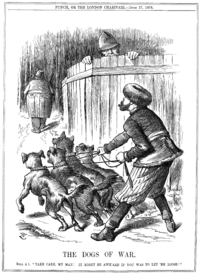
The Empire's First Constitutional era (or Birinci Meşrûtiyet Devri in Turkish), was short-lived; however, the idea behind it ( Ottomanism), proved influential as a wide-ranging group of reformers known as the Young Ottomans, primarily educated in Western universities, believed that a constitutional monarchy would provide an answer to the Empire's growing social unrest. Through a military coup in 1876, they forced Sultan Abdülaziz (1861–1876) to abdicate in favour of Murad V. However, Murad V was mentally ill, and was deposed within a few months. His heir-apparent Abdülhamid II (1876-1909) was invited to assume power on the condition that he would declare a constitutional monarchy, which he did on 23 November 1876. However, the parliament survived for only two years. The sultan suspended, but did not abolish, the parliament until he was forced to reconvene it. The effectiveness of Kanûn-ı Esâsî was then largely minimized.
The rise of nationalism swept through many countries during the 19th century, and the Ottoman Empire was not immune. A burgeoning national consciousness, together with a growing sense of ethnic nationalism, made nationalistic thought one of the most significant Western ideas imported to the Ottoman empire, as it was forced to deal with nationalism both within and beyond its borders. There was a significant increase in the number of revolutionary political parties. Uprisings in Ottoman territory had many far-reaching consequences during the 19th century and determined much of Ottoman policy during the early 20th century. Many Ottoman Turks questioned whether the policies of the state were to blame: some felt that the sources of ethnic conflict were external, and unrelated to issues of governance. While this era was not without some successes, the ability of the Ottoman state to have any effect on ethnic uprisings was seriously called into question. Greece declared its independence from the Empire in 1829 after the end of the Greek War of Independence. Reforms did not halt the rise of nationalism in the Danubian Principalities and Serbia, which had been semi-independent for almost six decades; in 1875 Serbia, Montenegro, Bosnia, Wallachia and Moldova declared their independence from the Empire; and following the Russo-Turkish War of 1877-78, independence was formally granted to Serbia, Romania and Montenegro, and autonomy to Bulgaria, with the other Balkan territories remaining under Ottoman control. A Serbian Jew, Yehuda Solomon Alkalai, encouraged a return to Zion and independence for Israel during this wave of decolonialization. Following defeat in the Russo-Turkish War of 1877-78, Cyprus was lent to the British in 1878 in exchange for Britain's favors at the Congress of Berlin. Egypt, which had previously been occupied by the forces of Napoleon I of France in 1798 but recovered in 1801 by a joint Ottoman-British force, was occupied in 1882 by British forces on the pretext of bringing order; though Egypt and Sudan remained Ottoman provinces de jure until 1914, when the Ottoman Empire joined the Central Powers of World War I, and Britain officially annexed these two provinces as a response. Other Ottoman provinces in North Africa were lost between 1830 and 1912, starting from Algeria (occupied by France in 1830), Tunisia (occupied by France in 1881) and Libya (occupied by Italy in 1912.)
Economically, the Empire had difficulty in repaying the Ottoman public debt to European banks, which caused the establishment of the Council of Administration of the Ottoman Public Debt. By the end of the 19th century, the main reason the Empire was not entirely overrun by Western powers came from the Balance of Power doctrine. Both Austria and Russia wanted to increase their spheres of influence and territory at the expense of the Ottoman Empire, but were kept in check mostly by the United Kingdom, which feared Russian dominance in the Eastern Mediterranean.
Dissolution (1908–1922)
The Second Constitutional Era ( Turkish: İkinci Meşrûtiyet Devri'') established after the Young Turk Revolution ( 3 July 1908) with the sultan's announcement of the restoration of the 1876 constitution and the reconvening of the Ottoman Parliament marks the dissolution of the Ottoman Empire. This era is dominated by the politics of the Committee of Union and Progress ( Turkish: İttihâd ve Terakkî Cemiyeti), and the movement that would become known as the Young Turks ( Turkish: Jön Türkler). Profiting from the civil strife, Austria-Hungary officially annexed Bosnia and Herzegovina in 1908. During the Italo-Turkish War (1911-1912), the Balkan League declared war against the Ottoman Empire, which lost its Balkan territories except Thrace and the historic Ottoman capital city of Edirne (Adrianople) with the Balkan Wars (1912–1913). The Baghdad Railway under German control became a source of international tension and played a role in the origins of World War I. The Ottoman Empire entered the First World War after the pursuit of Goeben and Breslau and took part in the Middle Eastern theatre on the side of the Central Powers. There were several important victories in the early years of the war, such as the Battle of Gallipoli and the Siege of Kut; but there were setbacks as well, such as the disastrous Caucasus Campaign against the Russians. The Arab Revolt which began in 1916 turned the tide against the Ottomans at the Middle Eastern front, where they initially seemed to have the upper hand.
The interior minister of the period, Talat Pasha, expressing the fear that the ethnic Armenians of the Empire would form a Fifth Column, ordered the arrest of Armenian leaders with a circular on April 24, 1915 and sent a request for the Tehcir Law on May 29, 1915, which initiated large scale deportations and massacres of the Armenians. In response was the creation of an Armenian resistance (April 1915) movement in the province of Van and the establishment of an Armenian Administration. The Ottoman government had accused the Armenians of being in collaboration with the invading Russian forces in eastern Anatolia against their native state because of the Armenian volunteer units in the Russian Army. Organized by the Ottoman government of that time, the Ottoman soldiers and Kurdish warlords killed Armenians indiscriminately both in their villages and as they marched south to camps in the Syrian Desert, during what is known as the Armenian Genocide.
When the Armistice of Mudros was signed in 1918, Yemen, together with Medina, was the only part of the Arabian peninsula that was still under Ottoman control. However, the Ottomans were eventually forced to cede Yemen and Medina following the armistice, along with parts of present-day Georgia, Armenia and Azerbaijan which were gained by the Ottoman forces during the final stages of the war, following the Russian Revolution of 1917. Under the terms of the Treaty of Sèvres, the partitioning of the Ottoman Empire was solidified. The new countries created from the remnants of the Empire currently number 40 (including the disputed Turkish Republic of Northern Cyprus). Given the fact that the Turkish peasantry of Anatolia dropped to 40% of the pre-war levels, regardless of the method used in calculations, the Ottoman Empire's casualties during World War I were significant.
The occupation of Constantinople along with the occupation of Smyrna mobilized the establishment of the Turkish national movement, which won the Turkish War of Independence (1919–1922) under the leadership of Mustafa Kemal Pasha. The Sultanate was abolished on November 1, 1922, and the last sultan, Mehmed VI Vahdettin (reigned 1918–1922), left the country on November 17, 1922. The new independent Grand National Assembly of Turkey (GNA) was internationally recognized with the Treaty of Lausanne on July 24, 1923. The GNA officially declared the Republic of Turkey on October 29, 1923. The Caliphate was constitutionally abolished several months later, on March 3, 1924. The Sultan and his family were declared persona non grata of Turkey and exiled. Fifty years later, in 1974, the GNA granted descendants of the former Ottoman dynasty the right to acquire Turkish citizenship.
Fall of the Empire

The fall of the Ottoman Empire can be attributed to the failure of its economic structure; the size of the Empire created difficulties in economically integrating its diverse regions. Also, the Empire's communication technology was not developed enough to reach all territories. In many ways, the circumstances surrounding the Ottoman Empire's fall closely paralleled those surrounding the fall of the Roman Empire, particularly in terms of the ongoing tensions between the Empire's different ethnic groups, and the various governments' inability to deal with these tensions. In the case of the Ottomans, the introduction of increased cultural rights, civil liberties and a parliamentary system during the Tanzimat proved too late to reverse the nationalistic and secessionist trends that had already been set in motion since the early 19th century.
Economy
|
Economic History
of the Ottoman Empire |
||
|---|---|---|
| Enlargement Era | ||
| Reformation Era | ||
Ottoman government deliberately pursued a policy for the development of Bursa, Edirne (Adrianople) and Constantinople, successive Ottoman capitals, into major commercial and industrial centres, considering that merchants and artisans were indispensable in creating a new metropolis. To this end, Mehmed and his successor Bayezid, also encouraged and welcomed migration of the Jews from different parts of Europe, who were settled in Constantinople and other port cities like Salonica. In many places in Europe, Jews were suffering persecution at the hands of their Christian counterparts. The tolerance displayed by the Ottomans was welcomed by the immigrants. The Ottoman economic mind was closely related to the basic concepts of state and society in the Middle East in which the ultimate goal of a state was consolidation and extension of the ruler's power, and the way to reach it was to get rich resources of revenues by making the productive classes prosperous. The ultimate aim was to increase the state revenues as much as possible without damaging the prosperity of subjects to prevent the emergence of social disorder and to keep the traditional organization of the society intact.
The organization of the treasury and chancery were developed under the Ottoman Empire more than any other Islamic government and, until the 17th century, they were the leading organization among all of their contemporaries. This organization developed a scribal bureaucracy (known as "men of the pen") as a distinct group, partly highly trained ulema, which developed into a professional body. The effectiveness of this professional financial body stands behind the success of many great Ottoman statesmen. The economic structure of the Empire was defined by its geopolitical structure. The Ottoman Empire stood between the West and the East, thus blocking the land route eastward and forcing Spanish and Portuguese navigators to set sail in search of a new route to the Orient. The Empire controlled the spice route that Marco Polo once used. When Christopher Columbus first journeyed to the Bahamas in 1492, the Ottoman Empire was at its zenith, an economic power that extended over three continents. Modern Ottoman studies think that the change in relations between the Ottomans and central Europe was caused by the opening of the new sea routes. It is possible to see the decline in the significance of the land routes to the East as Western Europe opened the ocean routes that bypassed the Middle East and Mediterranean as parallel to the decline of the Ottoman Empire itself. The Anglo-Ottoman Treaty, also known as the Treaty of Balta Liman that opened the Ottoman markets directly to English and French competitors, would should be seen as one of the staging posts along this development.
By developing commercial centres and routes, encouraging people to extend the area of cultivated land in the country and international trade through its dominions, the state performed basic economic functions in the Empire. But in all this the financial and political interests of the state were prevalent and the Ottoman administrators could not have realized, within the social and political system they were living in, the dynamics and principles of the capitalist economy of the Modern Age.
The exact amount of annual income the Ottoman government received, is a matter of considerable debate, due to the scantness and ambiguous nature of the primary sources. The following table contains approximate estimates.
| Year | Annual Revenue |
| 1433 | 2,500,000 ducats |
| 1496 | 3,300,000 ducats |
| 1520 | 3,130,000 ducats |
| 1526 | 4,500,000 ducats |
| 1530 | 6,000,000 ducats |
| 1553 | 7,166,000 ducats |
| 1558 | 7,740,000 ducats |
| 1566 | 8,000,000 ducats |
| 1587 | 9,000,000 ducats |
| 1592 | 10,000,000 ducats |
| 1603 | 8,000,000 ducats |
| 1660 | 12,000,000 ducats |
State
| State organisation of the Ottoman Empire |
|
|---|---|
| House of Osman ( Ottoman Dynasty) | |
| Grand Vizier ( 1320–1922) | |
| Dīvān ( 1586?–1908) | |
| Imperial Government (1908–1920) | |
| See also |
Subdivisions – Vassal & tributary states |
The state organisation of the Ottoman Empire was a very simple system that had two main dimensions: the military administration and the civic administration. Sultan was the highest position in the system. The civic system was based on local administrative units based on the region's characteristics. The Ottomans practiced a system in which the state had control over the clergy, like the Byzantine. Certain pre-Islamic Turkish traditions that had survived the adoption of administrative and legal practices from Islamic Iran remained important in Ottoman administrative circles. According to Ottoman understanding, the state's primary responsibility was to defend and extend the land of the Muslims and to ensure security and harmony within its borders within the overarching context of orthodox Islamic practice and dynastic sovereignty.
The " Ottoman dynasty" or, as an institution, " House of Osman" was unprecedented and unequaled in the Islamic world for its size and duration. The Ottoman dynasty was ethnically Turkish in its origins, as were some of its supporters and subjects, however the dynasty immediately lost this " Turkic" identification through intermarriage with many different ethnicities. On eleven occasions, the sultan was deposed because he was perceived by his enemies as a threat to the state. There were only two attempts in the whole of Ottoman history to unseat the ruling Osmanlı dynasty, both failures, which is suggestive of a political system that for an extended period was able to manage its revolutions without unnecessary instability.
The highest position in Islam, caliphate, was claimed by the sultan which was established as Ottoman Caliphate. The Ottoman sultan, pâdişâh or "lord of kings", served as the Empire's sole regent and was considered to be the embodiment of its government, though he did not always exercise complete control. The Imperial Harem was one of the most important powers of the Ottoman court. It was ruled by the Valide Sultan. On occasion, the Valide Sultan would become involved in state politics. For a period of time the women of the Harem effectively controlled the state in what was termed the " Sultanate of Women". New sultans were always chosen from among the sons of the previous sultan. The strong educational system of the palace school geared towards eliminating the unfit potential heirs, and establishing support amongst the ruling elite for a successor. The palace schools, which would also educate the future administrators of the state, were not a single track. First, the Madrasa ( Ottoman Turkish: Medrese) was designated for the Muslims, and educated scholars and state officials in accordance with Islamic tradition. The financial burden of the Medrese was supported by vakifs, allowing children of poor families to move to higher social levels and income. The second track was a free boarding school for the Christians, the Enderûn, which recruited 3,000 students annually from Christian boys between eight and twenty years old from one in forty families among the communities settled in Rumelia and/or the Balkans, a process known as Devshirmeh (Devşirme).
Though the sultan was the supreme monarch, the sultan's political and executive authority was delegated. The politics of the state had a number of advisors and ministers gathered around a council known as Divan (after the 17th century it was renamed the " Porte"). The Divan, in the years when the Ottoman state was still a Beylik, was composed of the elders of the tribe. Its composition was later modified to include military officers and local elites (such as religious and political advisors). Later still, beginning in 1320, a Grand Vizier was appointed in order to assume certain of the sultan's responsibilities. The Grand Vizier had considerable independence from the sultan with almost unlimited powers of appointment, dismissal and supervision. Beginning with the late 16th century, sultans withdrew from politics and the Grand Vizier became the de facto head of state. Throughout Ottoman history, there were many instances in which local governors acted independently, and even in opposition to the ruler. After the Young Turk Revolution of 1908, the Ottoman state became a constitutional monarchy. The sultan no longer had executive powers. A parliament was formed, with representatives chosen from the provinces. The representatives formed the Imperial Government of the Ottoman Empire.
The rapidly expanding empire used loyal, skilled subjects to manage the Empire, whether Albanians, Phanariot Greeks, Armenians, Serbs, Bosniaks, Hungarians or others. The incorporation of Greeks (and other Christians), Muslims, and Jews revolutionized its administrative system. This eclectic administration was apparent even in the diplomatic correspondence of the Empire, which was initially undertaken in the Greek language to the west.
The Tughra were calligraphic monograms, or signatures, of the Ottoman Sultans, of which there were 35. Carved on the Sultan's seal, they bore the names of the Sultan and his father. The prayer/statement “ever victorious” was also present in most. The earliest belonged to Orhan Gazi. The ornately stylized Tughra spawned a branch of Ottoman-Turkish calligraphy.
Society
| Social structure of the Ottoman Empire |
|
|---|---|
| Millet Jews · Armenians · Greeks |
|
| Rise of nationalism Ottomanism |
|
| Lifestyle · Ottoman court | |
| See also | |
| Slavery · Devşirme | |
One of the successes of the social structure of the Ottoman Empire was the unity that it brought about among its highly varied populations through an organization named as millets. The Millets were the major religious groups that were allowed to establish their own communities under Ottoman rule. The Millets were established by retaining their own religious laws, traditions, and language under the general protection of the sultan. Plurality was the key to the longevity of the Empire. As early as the reign of Mehmed II, extensive rights were granted to Phanariot Greeks, and Jews were invited to settle in Ottoman territory. Ultimately, the Ottoman Empire's relatively high degree of tolerance for ethnic differences proved to be one of its greatest strengths in integrating the new regions but this non-assimilative policy became a weakness after the rise of nationalism. The dissolution of the Empire based on ethnic differentiation ( balkanization) brought the final end which the failed Ottomanism among the citizens and participatory politics of the first or the constitutional Era had successfully addressed. Numerous traditions and cultural traits of this previous empire (in fields such as architecture, cuisine, music, leisure and government) were adopted by the Ottomans, who elaborated them into new forms. These cultural traits were later blended with the characteristics of the ethnic and religious groups living within the Ottoman territories, which resulted in a new and distinctively Ottoman cultural identity.
The lifestyle of the Ottoman Empire was a mixture of western and eastern life. One unique characteristic of Ottoman life style was it was very fragmented. The millet concept generated this fragmentation and enabled many to coexist in a mosaic of cultures. The capital of the Ottoman Empire, Constantinople also had a unique culture, mainly because prior to Ottoman rule it had been the seat of both the Roman and Byzantine Empires. The lifestyle in the Ottoman court in many aspects assembled ancient traditions of the Persian Shahs, but had many Greek and European influences. The culture that evolved around the Ottoman court was known as the Ottoman Way, which was epitomized with the Topkapı Palace. There were also large metropolitan centers where the Ottoman influence expressed itself with a diversity similar to metropolises of today: Sarajevo, Skopje, Thessaloniki, Dimashq, Baghdad, Beirut, Jerusalem, Makkah and Algiers with their own small versions of Ottoman Provincial Administration replicating the culture of the Ottoman court locally. The seraglio, which were the non-imperial places, in the context of the Turkish fashion, became the subject of works of art, where non-imperial prince or referring to other grand houses built around courtyards.
Slavery in the Ottoman Empire was a part of Ottoman society. As late as 1908 women slaves were still sold in the Empire. During the 19th century the Empire came under pressure from Western European countries to outlaw the practice. Policies developed by various Sultans throughout the 19th century attempted to curtail the slave trade but, since slavery did have centuries of religious backing and sanction, they could never directly abolish the institution outright — as had gradually happened in Western Europe and the Americas.
| Year | Population | |
|---|---|---|
| 1520 | 11,692,480 | |
| 1566 | 15,000,000 | |
| 1683 | 30,000,000 | |
| 1831 | 7,230,660 | |
| 1856 | 35,350,000 | |
| 1881 | 17,388,604 | |
| 1906 | 20,884,000 | |
| 1914 | 18,520,000 | |
| 1919 | 14,629,000 |
Culture
| Culture of the Ottoman Empire |
||
|---|---|---|
| Architecture · Cuisine Music · Ottoman Turkish |
||
| Poetry · Prose · Miniature | ||
| Oil wrestling | ||
The Ottoman Empire had filled roughly the territories around the Mediterranean Sea and Black Sea, while adopting their traditions, art and institutions of cultures in these regions; and adding new dimensions to them. Many different cultures lived under the umbrella of the Ottoman Empire, and as a result, a specifically "Ottoman" culture can be difficult to define, except for those of the regional centers and capital. However, there was also, to a great extent, a specific melding of cultures that can be said to have reached its highest levels among the Ottoman elite, who were composed of myriad ethnic and religious groups. This multicultural perspective of " millets" was reflected in the Ottoman State's multi-cultural and multi-religious policies. As the Ottomans moved further west, the Ottoman leaders absorbed some of the culture of the conquered regions. Intercultural marriages also played their part in creating the characteristic Ottoman elite culture. When compared to the Turkish folk culture, the influence of these new cultures in creating the culture of the Ottoman elite was very apparent.
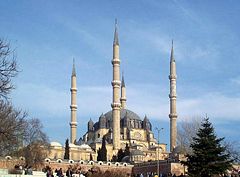
" Ottoman architecture" was influenced by Persian Architecture, Byzantine Greek, and Islamic architecture. The Ottoman architecture are a continuation of the pre-Islamic Persian Sassanid architecture. For instance, the dome covered square, which had been a dominant form in Sassanid became the nucleus of all Ottoman architecture. During the Rise period the early or first Ottoman architecture period, the Ottoman art was in search of new ideas. The growth period of the Empire become the classical period of architecture, which Ottoman art was at its most confident. During the years of the Stagnation period, Ottoman architecture moved away from this style however.
During the Tulip Era, it was under the influence of the highly ornamented styles of Western Europe; Baroque, Rococo, Empire and other styles intermingled. Concepts of Ottoman architecture mainly circle around the mosque. The mosque was integral to society, city planning and communal life. Besides the mosque, it is also possible to find good examples of Ottoman architecture in soup kitchens, theological schools, hospitals, Turkish baths and tombs.
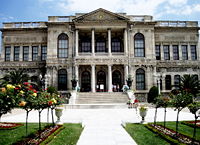
Examples of Ottoman architecture of the classical period, aside from İstanbul and Edirne, can also be seen in Egypt, Eritrea, Tunisia, Algiers, the Balkans and Hungary, where mosques, bridges, fountains and schools were built. The art of Ottoman decoration developed with a multitude of influences due to the wide ethnic range of the Ottoman Empire. The greatest of the court artisans enriched the Ottoman Empire with many pluralistic artistic influences: such as mixing traditional Byzantine art with elements of Chinese art.
" Ottoman Turkish language" was a variety of Turkish, highly influenced by Persian and Arabic. Ottomans had three influential languages; Turkish, Persian, Arabic but they did not have a parallel status. Throughout the vast Ottoman bureaucracy and, in particular, within the Ottoman court in later times, a version of Turkish was spoken, albeit with a vast mixture of both Arabic and Persian grammar and vocabulary. If the basic grammar was still largely Turkish, the inclusion of virtually any word in Arabic or Persian in Ottoman made it a language that was essentially incomprehensible to any Ottoman subject who had not mastered Arabic, Persian or both. The two varieties of the language became extremely differentiated and this resulted in a low literacy rate among the general public (about 2–3% until the early 19th century and just about 15% at the end of 19th century). Consequently, ordinary people had to hire special "request-writers" (arzıhâlcis) in order to be able to communicate with the government. The ethnic groups continued to speak within their families and neighborhoods ( mahalles) with their own languages (e.g., Jews, Greeks, Armenians, etc.) In villages where two or more populations lived together, the inhabitants would often speak each other's language. In cosmopolitan cities, people often spoke their family languages, some Ottoman or Persian if they were educated, and some Arabic if they were Muslim. In the last two centuries, French and English emerged as popular languages, especially among the Christian Levantine communities. The elite learned French at school, and used European products as a fashion statement. The use of Turkish grew steadily under the Ottomans, but, since they were still interested in their two other official languages, they kept these in use as well. Usage of these came to be limited, though, and specific: Persian served mainly as a literary language, while Arabic was used solely for religious rites. At this time many famous Persian poets emerged.
" Ottoman classical music" was an important part of the education of the Ottoman elite, a number of the Ottoman sultans were accomplished musicians and composers themselves, such as Selim III, whose compositions are still frequently performed today. Ottoman classical music arose largely from a confluence of Byzantine music, Arabic music, and Persian music. Compositionally, it is organised around rhythmic units called usul, which are somewhat similar to meter in Western music, and melodic units called makam, which bear some resemblance to Western musical modes. The instruments used are a mixture of Anatolian and Central Asian instruments (the saz, the bağlama, the kemence), other Middle Eastern instruments (the ud, the tanbur, the kanun, the ney), and — later in the tradition — Western instruments (the violin and the piano). Because of a geographic and cultural divide between the capital and other areas, two broadly distinct styles of music arose in the Ottoman Empire: Ottoman classical music, and folk music. In the provinces, several different kinds of Folk music were created. The most dominant regions with their distinguished musical styles are: Balkan-Thracian Türküs, North-Eastern ( Laz) Türküs, Aegean Türküs, Central Anatolian Türküs, Eastern Anatolian Türküs, and Caucasian Türküs. Some of the distinctive styles were: Janissary Music, Roma music, Belly dance, Turkish folk music.
" Ottoman cuisine" refers to the cuisine of the capital — Constantinople, and the regional capital cities, where the melting pot of cultures created a common cuisine that all the populations enjoyed. This diverse cuisine was honed in the Imperial Palace's kitchens by chefs brought from certain parts of the Empire to create and experiment with different ingredients. The creations of the Ottoman Palace's kitchens filtered to the population, for instance through Ramadan events, and through the cooking at the Yalıs of the Pashas, and from there on spread to the rest of the population. Today, Ottoman cuisine lives in the Balkans, Anatolia and the Middle East, "common heirs to what was once the Ottoman life-style, and their cuisines offer treacherous circumstantial evidence of this fact". It is typical of any great cuisine in the world to be based on local varieties and on mutual exchange and enrichment among them, but at the same time to be homogenized and harmonized by a metropolitan tradition of refined taste.
Religion
Before adopting Islam — a process that was greatly facilitated by the Abbasid victory at the 751 Battle of Talas, which ensured Abbasid influence in Central Asia — the Turkic peoples practised a variety of shamanism. After this battle, many of the various Turkic tribes — including the Oghuz Turks, who were the ancestors of both the Seljuks and the Ottomans — gradually converted to Islam, and brought the religion with them to Anatolia beginning in the 11th century.
The Ottoman Empire was, in principle, tolerant towards Christians and Jews (the "Ahl Al-Kitab", or "People of the Book", according to the Qu'ran) but not towards the polytheists, in accordance with the Sharia law. Such tolerance was subject to a non-Muslim tax, the Jizya.
Under the millet system, non-Muslim people were considered subjects of the Empire, but were not subject to the Muslim faith or Muslim law. The Orthodox millet, for instance, was still officially legally subject to Justinian's Code, which had been in effect in the Byzantine Empire for 900 years. Also, as the largest group of non-Muslim subjects (or zimmi) of the Islamic Ottoman state, the Orthodox millet was granted a number of special privileges in the fields of politics and commerce, in addition to having to pay higher taxes than Muslim subjects.,
The Ottoman Sultan Mehmed II allowed the local Christians to stay in Constantinople (Istanbul) after conquering the city in 1453, and to retain their institutions such as the Greek Orthodox Patriarchate. In 1461 Sultan Mehmed II established the Armenian Patriarchate of Constantinople. Previously, the Byzantines considered the Armenian Church as heretical and thus did not allow them to build churches inside the walls of Constantinople. In 1492, when the Muslims and Sephardic Jews were expelled from Spain during the Spanish Inquisition, the Ottoman Sultan Bayezid II sent his fleet under Kemal Reis to save them and granted the refugees the right to settle in the Ottoman Empire.
The state's relationship with the Greek Orthodox Church was largely peaceful, and recurrent oppressive measures taken against the Greek church were a deviation from generally established practice. The church's structure was kept intact and largely left alone but under close control and scrutiny until the Greek War of Independence of 1821–1831 and, later in the 19th and early 20th centuries, the rise of the Ottoman constitutional monarchy, which was driven to some extent by nationalistic currents, tried to be balanced with Ottomanism. Other Orthodox churches, like the Bulgarian Orthodox Church, were dissolved and placed under the jurisdiction of the Greek Orthodox Patriarchate; until Sultan Abdülaziz established the Bulgarian Exarchate in 1870 and reinstated the autonomy of the Bulgarian Church.
Similar millets were established for the Ottoman Jewish community, who were under the authority of the Haham Başı or Ottoman Chief Rabbi; the Armenian Orthodox community, who were under the authority of a head bishop; and a number of other religious communities as well.
Law

Ottoman legal system accepted the Religious law over its subjects. The Ottoman Empire was always organized around a system of local jurisprudence. Legal administration in the Ottoman Empire was part of a larger scheme of balancing central and local authority. Ottoman power revolved crucially around the administration of the rights to land, which gave a space for the local authority develop the needs of the local millet. The jurisdictional complexity of the Ottoman Empire was aimed to permit the integration of culturally and religiously different groups. The Ottoman system had three court systems: one for Muslims, one for non-Muslims, involving appointed Jews and Christians ruling over their respective religious communities, and the "trade court". The entire system was regulated from above by means of the administrative Kanun, i.e. laws, a system based upon the Turkic Yasa and Töre which were developed in the pre-Islamic era. The kanun law system, on the other hand, was the secular law of the sultan, and dealt with issues not clearly addressed by the sharia system.
These court categories were not, however, wholly exclusive in nature: for instance, the Islamic courts — which were the Empire's primary courts — could also be used to settle a trade conflict or disputes between litigants of differing religions, and Jews and Christians often went to them so as to obtain a more forceful ruling on an issue. The Ottoman state tended not to interfere with non-Muslim religious law systems, despite legally having a voice to do so through local governors. The Islamic Sharia law system had been developed from a combination of the Qur'ān; the Hadīth, or words of the prophet Muhammad; ijmā', or consensus of the members of the Muslim community; qiyas, a system of analogical reasoning from previous precedents; and local customs. Both systems were taught at the Empire's law schools, which were in Constantinople and Bursa.
Tanzimat reforms, had a drastic effect on the law system. In 1877, the civil law (excepting family law) was codified in the Mecelle code. Later codifications covered commercial law, penal law and civil procedure.
Military
Ottoman Army
The first military unit of the Ottoman State was an army that was organized by Osman I from the tribesmen inhabiting western Anatolia in the late 13th century. The military system became an intricate organization with the advance of the Empire.
The Ottoman military was a complex system of recruiting and fief-holding. The main corps of the Ottoman Army included:
- Janissary: Infantry units recruited at a very young age from the non-Muslim ethnic groups of the Empire and raised as Muslim Turkish warriors; also forming the Sultan's household troops and bodyguard. Most of the recruits were Christian Balkans.
- Sipahi: Elite cavalry knights who were granted tımars ( fiefs) throughout the Empire's lands. Their alternative name was Tîmârlı Sipahi (Enfiefed Knight).
- Akıncı: Frontline cavalry units of the Ottoman Army which raided and scouted the border areas and outposts. These units were known as ghazis before the establishment of the Ottoman army and contributed significantly to early Ottoman success against an incompetent Byzantine army.
- Mehterân: Ottoman Army Band which played martial tunes during military campaigns. The mehterân was usually associated with the Janissary corps.
The Ottoman army was once among the most advanced fighting forces in the world, being one of the first to employ muskets. The Ottoman cavalry used bows and short swords and often applied nomad tactics similar to those of the Mongol Empire; such as pretending to retreat while surrounding the enemy forces inside a crescent-shaped formation and then making the real attack.
Starting from the Battle of Kosovo in 1389 and the Battle of Nicopolis in 1396, the Ottoman army quickly advanced towards central Europe, capturing Hungary with the Battle of Mohács in 1526 and twice laying siege to Vienna, in 1529 and 1683. However, the decline in the army's performance became evident from the mid 17th century and after the Great Turkish War, the Ottoman army's reputation as one of the most feared fighting forces in the world was never regained. The 18th century saw some limited success against Venice, but in the north the European-style Russian armies forced the Ottomans to concede land.
The modernization of the Ottoman Empire in the 19th century started with the military. In 1826 Sultan Mahmud II abolished the Janissary corps (which had become obsolete in battle, but effective deposing sultans) and established the modern Ottoman army, which he named as the Nizam-ı Cedid (New Order). The Ottoman army was also the first institution to hire foreign experts and send its officers for training in western European countries. Consequently, the Young Turks movement first began when these relatively young and newly trained men returned with their education.
Ottoman Navy
The conquest of İmralı Island in the Sea of Marmara in 1308 marked the first Ottoman naval victory (for a timeline of the naval actions of the Ottoman fleet, see the History of the Turkish Navy). In 1321 the Ottoman fleet made its first landings on Thrace in southeastern Europe, and vastly contributed to the expansion of the Empire's territories on the European continent. The Ottoman navy was one of the first to use cannons, and the Battle of Zonchio in 1499 went down in history as the first naval battle where cannons were used on ships. It was also the Ottoman navy which initiated the conquest of North Africa, with the addition of Algeria and Egypt to the Ottoman Empire in 1517. The Battle of Preveza in 1538 and the Battle of Djerba in 1560 marked the apex of Ottoman naval domination in the Mediterranean Sea. The Ottomans also confronted the Portuguese forces based in Goa at the Indian Ocean in numerous battles between 1538 and 1566. In 1553, the Ottoman admiral Salih Reis conquered Morocco and the lands of North Africa beyond the Strait of Gibraltar, extending Ottoman territory into the Atlantic Ocean. In 1566 the Sultan of Aceh asked for support against the Portuguese and declared allegiance to the Ottoman Empire, which sent its Indian Ocean fleet under Kurtoğlu Hızır Reis to Sumatra. The fleet landed at Aceh in 1569, and the event marked the easternmost Ottoman territorial expansion. In 1585 the Ottoman admiral Murat Reis captured Lanzarote of the Canary Islands. In 1617 the Ottoman fleet captured Madeira in the Atlantic Ocean, before raiding Sussex, Plymouth, Devon, Hartland Point, Cornwall and the other counties of western England in August 1625. In 1627 Ottoman naval ships, accompanied by corsairs from the Barbary Coast, raided the Shetland Islands, Faroe Islands, Denmark, Norway and Iceland. Between 1627 and 1631 the same Ottoman force also raided the coasts of Ireland and Sweden. In 1655 a force of 40 Ottoman ships captured the Isle of Lundy in the Bristol Channel, which served as the main base for Ottoman naval and privateering operations in the North Atlantic until 1660, when Ottoman ships appeared off the eastern coasts of North America, particularly being sighted at the British colonies like Newfoundland and Virginia. The overseas territorial acquisitions of the Ottoman Navy further expanded the extent of the Ottoman sphere of influence on distant lands in both the Indian and Atlantic oceans, such as the addition of Aceh (1569) as a vassal state to the Ottoman Empire, and temporary occupations like those of Lanzarote (1585), Madeira (1617), Vestmannaeyjar (1627) and Lundy (1655–1660).
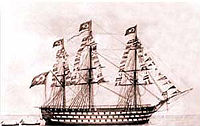
Following defeat against the combined British-French-Russian navies at the Battle of Navarino in 1827, and the subsequent loss of Algeria (1830) and Greece (1832), Ottoman naval power, and control over the Empire's distant overseas territories declined. Sultan Abdülaziz (reigned 1861–1876) attempted to reestablish a strong Ottoman navy, building the third largest fleet after that of Britain and France with 21 battleships and 173 other types of warships. The shipyard at Barrow, United Kingdom built its first submarine in 1886 for the Ottoman Empire. The submarine Abdul Hamid achieved fame as the world’s first to fire a torpedo underwater. But the collapsing Ottoman economy could not sustain the fleet strength. Sultan Abdülhamid II (reigned 1876–1908) distrusted the navy, when the admirals supported the reformist Midhat Pasha and the First Ottoman Parliament of 1876. Claiming that the large and expensive navy was of no use against the Russians during the Russo-Turkish War (1877–1878), he locked most of the fleet inside the Golden Horn, where the ships decayed for the next 30 years.
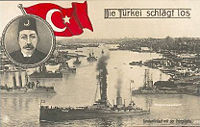
Following the Young Turk Revolution in 1908, the Committee of Union and Progress which effectively took control of the country sought to develop a strong Ottoman naval force. The poor condition of the fleet during the Ottoman Naval Parade of 1910 saddened every Turk who saw it, and the Ottoman Navy Foundation was established in order to purchase new ships through public donations. Those who made donations received different types of medals according to the size of their contributions. With this public money, the Ottoman government ordered large battleships like Sultan Osman I and Reşadiye, but despite the payment for both ships, the United Kingdom confiscated them at the outbreak of World War I and renamed them as HMS Agincourt and HMS Erin. This caused some ill-feeling towards Britain among the Ottoman public, and the German Empire took advantage of the situation by sending the battlecruiser Yavuz Sultan Selim and light cruiser Midilli which entered service in the Ottoman fleet. This event significantly contributed to the decision of supporting Germany in the First World War, with whom the Ottomans sided.
Ottoman Air Force
The Ottoman Air Force was founded in June 1909, making it one of the first combat aviation organizations in the world. Its formation came about after the Ottoman Empire sent two Turkish pilots to the International Aviation Conference in Paris. After witnessing the growing importance of an air combat support branch, the Ottoman government decided to organize its own military aviation program. For this purpose, officers were sent to Europe by the end of 1910 to participate in the study of combat flight. However, because of bad living conditions, the student program was aborted and the trainees returned to Turkey in early 1911. Although left without any governmental guidelines for establishing an air force, the Ottoman Minister of Defence of the time, Mahmut Şevket Paşa, continued to encourage the idea of a military aviation program and sent officers Fesa and Yusuf Kenan, who achieved the highest maneuvering points in a piloting test conducted in 1911, to France for receiving a more satisfactory flight education. In late 1911 Süreyya Ilmen was instructed with founding the Havacılık Komisyonu (Aviation Commission) bound to the Harbiye Bakanlığı Fen Kıtaları Müstahkem Genel Müfettişliği (War Ministry Science Detachment General Inspectorship). On February 21, 1912, Fesa and Yusuf Kenan completed their flight education and returned home with the 780th and 797th French aviation diplomas. In the same year, eight more Turkish officers were sent to France for flight education.
The Ottoman Empire started preparing its first pilots and planes, and with the founding of the Hava Okulu (Air Academy) in Constantinople on July 3, 1912, the Empire began to tutor its own flight officers. The founding of the Air Academy quickened advancement in the military aviation program, increased the number of enlisted persons within it, and gave the new pilots an active role in the Armed Forces. In May 1913 the world's first specialized Reconnaissance Training Program was activated by the Air Academy and the first separate Reconnaissance division was established by the Air Force.
Because of the lack of experience of the Turkish pilots, the first stage (1912) of the Balkan Wars (1912–1913) ended with the loss of several aircraft. However, the second stage (1913) was marked with great success since the pilots had become more battle-hardened. Many recruits joined the Air Academy following a surge of Turkish nationalism during the war.
With the end of the Balkan Wars a modernization process started and new planes were purchased. In June 1914 a new military academy, Deniz Hava Okulu (Naval Aviation Academy) was founded, also in Constantinople. With the outbreak of World War I, the modernization process stopped abruptly, but in 1915 some German officers came to the Ottoman Empire and some Turkish officers went to Germany for flight education.
The Ottoman Air Force fought on many fronts during World War I, from Galicia in the west to the Caucasus in the east and Yemen in the south. Efforts were made to reorganize the Ottoman Air Force, but this ended in 1918 with the end of World War I and the occupation of Constantinople.


